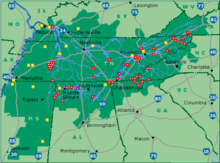Tennessee Valley Authority
The Tennessee Valley Authority (TVA) is a federally owned corporation in the United States created by congressional charter on May 18, 1933, to provide navigation, flood control, electricity generation, fertilizer manufacturing, and economic development to the Tennessee Valley, a region particularly affected by the Great Depression. Senator George W. Norris (R-Nebraska) was a strong sponsor of this project. TVA was envisioned not only as a provider, but also as a regional economic development agency that would use federal experts and rural electrification to help modernize the rural region's economy and society.[3]
 Logo of the TVA  Flag of the TVA | |
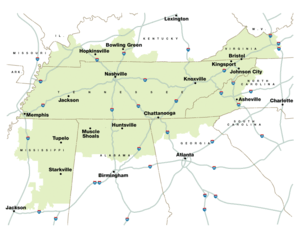 TVA service area | |
| State-owned enterprise | |
| Industry | Electric utility |
| Founded | September 18, 1933 |
| Headquarters | Knoxville, Tennessee, U.S. |
Key people | Vacant, chairman[1] Jeff Lyash, CEO[2] |
| Revenue | $11.2 billion USD (FY 2018 ending September 30, 2018) |
| $1.12 billion USD (FY 2018) | |
| Website | www |

TVA's service area covers most of Tennessee, portions of Alabama, Mississippi, and Kentucky, and small slices of Georgia, North Carolina, and Virginia. It was the first large regional planning agency of the federal government and remains the largest. Under the leadership of David Lilienthal ("Mr. TVA"), the TVA became a model for the United States' later efforts to help modernize agrarian societies in the developing world.[4]
Operation
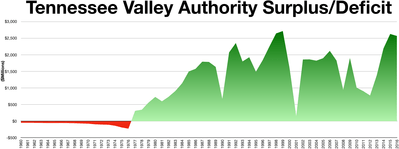

The Tennessee Valley Authority was initially founded as an agency to provide general economic development to the region through power generation, flood control, navigation assistance, fertilizer manufacturing, and agricultural development. Since the Depression years, it has developed primarily into a power utility. Despite its shares being owned by the federal government, TVA operates exactly like a private corporation, and receives no taxpayer funding.[5] The TVA Act authorizes the company to use eminent domain.[6]
TVA provides electricity to approximately ten million people through a diverse portfolio that includes nuclear, coal-fired, natural gas-fired, hydroelectric, and renewable generation. TVA sells its power to 154 local power utilities, 5 direct industrial and institutional customers, and 12 area utilities.[7] In addition to power generation, TVA provides flood control with its 29 hydroelectric dams. Resulting lakes and other areas also allow for recreational activities. The TVA also provides navigation and land management along rivers within its region of operation.[5] TVA also assists governments and private companies on economic development projects.[5]
TVA has a nine-member board of directors, each nominated by the United States President and confirmed by the United States Senate. The part-time members serve five-year terms and receive an annual stipend of $45,000 ($50,000 for the chairman). The board members choose the chief executive officer (CEO).[8] TVA's headquarters are located in downtown Knoxville, with large administrative offices in Chattanooga (training/development; supplier relations; power generation and transmission) and Nashville (economic development) in Tennessee and Muscle Shoals, Alabama.
The Tennessee Valley Authority Police are the primary law enforcement agency for the company. Initially part of the TVA, in 1994 the TVA Police was authorized as a federal law enforcement agency.
History
Background
During the 1920s and the 1930s Great Depression years, Americans began to support the idea of public ownership of utilities, particularly hydroelectric power facilities. The concept of government-owned generation facilities selling to publicly owned distribution utilities was controversial and remains so today.[9] Many believed privately owned power companies were charging too much for power, did not employ fair operating practices, and were subject to abuse by their owners (utility holding companies), at the expense of consumers.
During his presidential campaign, Franklin D. Roosevelt said that private utilities had "selfish purposes" and said, "Never shall the federal government part with its sovereignty or with its control of its power resources while I'm president of the United States." The private sector practice of forming utility holding companies had resulted in their controlling 94 percent of generation by 1921, and they were essentially unregulated. In an effort to change this, Congress and Roosevelt enacted the Public Utility Holding Company Act of 1935 (P.U.H.C.A.).
After Roosevelt was elected, the federal government bought many private utility companies in the Tennessee Valley as part of the Tennessee Valley Authority project. Others shut down, unable to compete with the TVA. The government passed regulations to prevent competition with TVA.
In 1920 Senator George Norris (R-Nebraska) blocked a proposal from industrialist Henry Ford to build a private dam and utility to modernize the valley. Norris deeply distrusted privately owned utility companies, which controlled 94% of power generation in 1921. He gained passage of the Muscle Shoals Bill, to build a federal dam in the valley, but it was vetoed as socialistic by President Herbert Hoover in 1931. The idea behind the Muscle Shoals project in 1933 became a core part of President Franklin D. Roosevelt's New Deal Tennessee Valley Authority.[10]
Even by Depression standards, in 1933 the Tennessee Valley was in dire economic straits. Thirty percent of the population was affected by malaria. The average income in the rural area was $639 per year, with some families surviving on as little as $100 per year. Much of the land had been exhausted by poor farming practices, and the soil was eroded and depleted. Crop yields had fallen, reducing farm incomes. The best timber had been cut, and 10% of forests were lost to fires each year.[9]
Early history
.jpg)
President Franklin Delano Roosevelt signed the Tennessee Valley Authority Act (ch. 32, Pub.L. 73–17, 48 Stat. 58, enacted May 18, 1933, codified as amended at 16 U.S.C. § 831, et seq.), creating the TVA. TVA was designed to modernize the region, using experts and electricity to combat human and economic problems.[11] TVA developed fertilizers, and taught farmers ways to improve crop yields. In addition, it helped replant forests, control forest fires, and improve habitat for fish and wildlife. The most dramatic change in Valley life came from TVA-generated electricity from the dams it constructed on area rivers. With electricity, farms could be provided with lights and modern home appliances, making the lives of residents easier and farms more productive. The available electricity attracted new industries to the region, providing desperately needed jobs.[3]
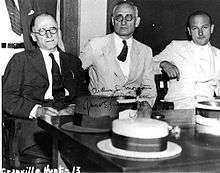
The development of the dams provided numerous construction jobs. At the same time, however, they required the displacement of more than 15,000 families. This created anti-TVA sentiment in some rural communities. In related projects, three towns had to be relocated, as were cemeteries. The TVA relocated and reinterred remains at new locations, together with replacing tombstones.[12]
Many local landowners were suspicious of government agencies, but TVA successfully introduced new agricultural methods into traditional farming communities by blending in and finding local champions. Tennessee farmers would often reject advice from TVA officials, so the officials had to find leaders in the communities and convince them that crop rotation and the judicious application of fertilizers could restore soil fertility. Once they had convinced the leaders, the rest followed.[13]
At its inception, TVA was based in Muscle Shoals, Alabama, but gradually moved its headquarters to Knoxville, Tennessee, where it is still based.[14] At one point, TVA's headquarters were housed in the Old Federal Customs House at the corner of Clinch Avenue and Market Street. The building is now operated as a museum and is listed on the National Register of Historic Places.[15] TVA was one of the first federal hydropower agencies. Today most of the nation's major hydropower systems are federally managed. But other attempts to create similar regional corporate agencies have failed, and the proposed Columbia Valley Authority for the Columbia River in the Pacific Northwest did not gain approval.[16]

The Authority hired many of the area's unemployed for a variety of jobs: they conducted conservation, economic development, and social programs. For instance, a library service was instituted for this area. The professional staff at headquarters were generally composed of experts from outside the region. By 1934, TVA employed more than 9,000 people.[17]
The workers were classified by the usual racial and gender lines of the region, which limited opportunities for minorities and women. TVA hired a few African Americans, generally restricted for janitorial or other low-level positions. TVA recognized labor unions; its skilled and semi-skilled blue collar employees were unionized, a breakthrough in an area known for corporations hostile to miners' and textile workers' unions. Women were excluded from construction work. TVA's cheap electricity attracted textile mills to the area, and they hired mostly women as workers.[18]
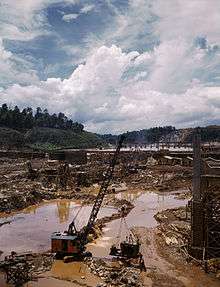
During World War II, the U.S. needed greater aluminum supplies to build airplanes. Aluminum plants required large amounts of electricity. To provide the power, TVA engaged in one of the largest hydropower construction programs ever undertaken in the U.S. By early 1942, when the effort reached its peak, 12 hydroelectric plants and one steam plant were under construction at the same time, and design and construction employment reached a total of 28,000. In its first eleven years, TVA constructed a total of 16 hydroelectric dams.[17]
The largest project of this period was the Fontana Dam. After negotiations led by Vice-President Harry Truman, TVA purchased the land from Nantahala Power and Light, a wholly owned subsidiary of Alcoa, and built Fontana Dam. Also in 1942, TVA's first coal-fired plant, the 267-megawatt Watts Bar Steam Plant, began operation.[19]
The government originally intended the electricity generated from Fontana to be used by Alcoa factories. By the time the dam generated power in early 1945, the electricity was directed to another purpose in addition to aluminum manufacturing. TVA also provided much of the electricity needed for uranium enrichment at Oak Ridge, Tennessee, as required for the Manhattan Project and the making of the atomic bomb.
Increasing power demand
By the end of World War II, TVA had completed a 650-mile (1050-kilometer) navigation channel the length of the Tennessee River and had become the nation's largest electricity supplier. Even so, the demand for electricity was outstripping TVA's capacity to produce power from hydroelectric dams, and so TVA began to construct coal-fired plants. Political interference kept TVA from securing additional federal appropriations to do so, so it sought the authority to issue bonds.[20] Several of TVA's coal-fired plants, including Johnsonville, Widows Creek, Shawnee, Kingston, Gallatin, and John Sevier, began operations in the 1950s.[21] In 1955 coal surpassed hydroelectricity as TVA's top generating source.[22] On August 6, 1959 President Dwight D. Eisenhower signed into law an amendment to the TVA act, making the agency self-financing.[23]
The 1960s were years of further unprecedented economic growth in the Tennessee Valley. Electric rates were among the nation's lowest and stayed low as TVA brought larger, more efficient generating units into service. Expecting the Valley's electric power needs to continue to grow, TVA began building nuclear reactors as a new source of cheap power.[24] During this decade (and the 1970s), TVA was engaged in what was up to that time its most controversial project – the Tellico Dam Project.[25] The project was initially conceived in the 1940s but not completed until 1979.
1970s and 1980s
Significant changes occurred in the economy of the Tennessee Valley and the nation, prompted by an international oil embargo in 1973 and accelerating fuel costs later in the decade. The average cost of electricity in the Tennessee Valley increased fivefold from the early 1970s to the early 1980s.
TVA's first nuclear reactor, Browns Ferry Unit 1, began operation in 1974.[26] In the early 1970s, TVA set out to construct a total of 17 nuclear reactors, due to a projection of further increase in power demand.[27] However, in the 1980s ten of these reactors were cancelled. On August 6, 1981 the Tennessee Valley Authority Board voted to defer the Phipps Bend plant, as well as to slow down construction on all other projects.[28] The Hartsville and Yellow Creek plants were cancelled in 1984 and Bellefonte in 1988.[27]
Construction of the Tellico Dam became controversial for environmental reasons, as laws had changed since early development in the valley. Scientists and other people had become more aware of the massive environmental effects of the dams and new lakes, and worried about preserving habitat and species. The Tellico Dam project was initially delayed because of concern over the snail darter, a threatened species. A lawsuit was filed under the Endangered Species Act and the U.S. Supreme Court ruled in favor of protecting the snail darter in Tennessee Valley Authority v. Hill.[29]
Marvin T. Runyon became chairman of the Tennessee Valley Authority in January 1988. He claimed to reduce management layers, cut overhead costs by more than 30%, and achieved cumulative savings and efficiency improvements of $1.8 billion. He said he revitalized the nuclear program and instituted a rate freeze that continued for ten years.[30]
Recent history
As the electric-utility industry moved toward restructuring and deregulation, TVA began preparing for competition. It cut operating costs by nearly $950 million a year, reduced its workforce by more than half, increased the generating capacity of its plants, and developed a plan to meet the energy needs of the Tennessee Valley through the year 2020.
In 1996, Watts Bar Unit 1 began operation. This was the last commercial nuclear reactor in the United States to begin operation in the 20th century.
In 2002, TVA began work to restart a previously mothballed nuclear reactor at Browns Ferry Unit 1, which was completed in May 2007. In 2004, TVA implemented recommendations from the Reservoir Operations Study (ROS) on how it operates the Tennessee River system (the nation's fifth largest). In 2005, the TVA announced its intention to construct an Advanced Pressurized Water Reactor at its Bellefonte site in Alabama (filing the necessary applications in November 2007). In 2007 it announced plans to complete the unfinished Unit 2 at Watts Bar.
On December 22, 2008, an earthen dike at TVA's Kingston Fossil Plant broke, spreading one billion gallons of wet coal ash across 300 acres (1.2 km2) of land and into the tributaries of the Tennessee River. This produced damage from high levels of metal in the river.[31] The TVA Office of the Inspector General's report, Inspection 2008-12283-02, Review of the Kingston Fossil Plant Ash Spill Cause Study and Observations About Ash Management, concluded that TVA culture had contributed to the spill.[32]
In 2009, to gain more access to sustainable, green energy, TVA signed 20-year power purchase agreements with Maryland-based CVP Renewable Energy Co. and Chicago-based Invenergy Wind LLC for electricity generated by wind farms.[33]
As of 2013, TVA carried $25 billion in debt, near the $30 billion debt limit imposed by Congress.[34]
In April 2011 TVA reached an agreement with the Environmental Protection Agency (EPA), four state governments, and three environmental groups to drastically reduce pollution and carbon emissions.[35] Under the terms of the agreement, TVA was required to retire at least 18 of its 59 coal-fired units by the end of 2018, and install scrubbers in several others or convert them to make them cleaner, at a cost of $25 billion by 2021.[35] As a result, TVA closed several of its coal-fired power plants in the 2010s, converting some of them to natural gas. These include John Sevier in 2012, Shawnee Unit 10 in 2014, Widows Creek in 2015, Colbert in 2016, Johnsonville and Paradise Units 1 and 2 in 2017, and Allen in 2018.[36]
In October 2016, Watts Bar Unit 2 began commercial operation. Watts Bar Unit 2 is the first, and so far only, new nuclear reactor to enter service in the United States in the 21st century.[37]
In 2018, TVA opened a new cybersecurity center in its downtown Chattanooga Office Complex. More than 20 IT specialists monitor emails, Twitter feeds and network activity for cybersecurity threats and threats to grid security. Across TVA's digital platform, 2 billion activities that occur each day. The center is manned 24 hours a day to spot any threats to TVA's 16,000 miles of transmission lines.[38]
Given continued economic pressure on the coal industry, the TVA board defied President Donald Trump and voted in February 2019 to close two aging coal plants, Paradise 3 and Bull Run. TVA chief executive Bill Johnson said the decision was not about coal per se, but rather "about keeping rates as low as feasible." The TVA stated that decommissioning the two plants would reduce its carbon output by about 4.4% annually.[39]
In early February 2020, TVA awarded an outside company, Framatome, several multi-million-dollar contracts for work across the company’s reactor fleet.[40] This includes fuel for the Browns Ferry Nuclear Plant, fuel handling equipment upgrades across the fleet and steam generator replacements at the Watts Bar Nuclear Plant. Framatome will provide its state-of-the-art ATRIUM 11 fuel for the three boiling water reactors at Browns Ferry with the first use planned for 2023. This contract makes TVA the third U.S. utility to switch to the ATRIUM 11 fuel design.[41]
On August 3, 2020, Donald Trump fired the TVA chairman and another board member, saying they were overpaid and because they outsourced 200 high-tech jobs. The move came after U.S. Tech Workers, a nonprofit that wants to limit visas given to foreign technology workers, criticized the TVA for laying off its own workers and replacing them with contractors using foreign workers with H-1B visas.[42]
Facilities
Power stations
With a generating capacity of approximately 35 gigawatts (GW), TVA has the sixth highest generation capacity of any utility company.[43] TVA's power mix as of 2020 is five coal-fired power plants, 29 hydroelectric dams, three nuclear plants (with seven operating reactors), nine simple-cycle natural gas combustion turbine plants, nine combined cycle gas plants, 1 pumped storage hydroelectric plant, 1 wind energy site, and 15 small solar energy sites.[44] In fiscal year 2018, nuclear generation made up about 40% of TVA's total, coal 26%, natural gas 20%, hydroelectric 10%, and wind and solar 3%.[44] TVA purchases about 15% of the power it sells from other power producers. It purchases power from natural gas combined cycles, coal, and wind, and other renewables.[45] The cost of Purchased Power is part of the "Fuel Cost Adjustment" (FCA) charge that is separate from the TVA Rate. Watts Bar Nuclear Plant produces tritium as a byproduct for the U.S. National Nuclear Security Administration, which requires tritium for nuclear weapons (for "boosted" fission primaries and for fusion secondaries).
Electric transmission
TVA is one of the largest operators of electric transmission in the US with an approximately 16,000-mile (26,000 km) corridor of transmission (13,000 miles (21,000 km) of which is greater than 161kv).[46]
Recreation
TVA has conveyed approximately 485,420 acres (1,964.4 km2) of property for recreation and preservation purposes including public parks; public access areas and roadside parks; wildlife refuges; national parks and forests; and other camps and recreation areas, which comprises approximately 759 different sites.[47]
Megasites
To qualify for a TVA Megasite certificate the qualifications are at least 1,000 acres, with interstate access, the potential for rail service, environmental impact study, and utility service capable of serving a major manufacturing facility. Seven TVA Megasites have been developed so far with capital investments of over $5 billion.[48]
Locations:
- Huntsville[49]
- Chattanooga
- Golden Triangle (Mississippi) (2 sites)[50]
- Hopkinsville, Kentucky
- Memphis Regional Megasite
- West Kentucky Megasite
Criticism
Allegations of federal government overreach
TVA was heralded by New Dealers and the New Deal Coalition not only as a successful economic development program for a depressed area but also as a democratic nation-building effort overseas because of its alleged grassroots inclusiveness as articulated by director David Lilienthal. However, the TVA was controversial early on, as some believed its creation was an overreach by the federal government.
Supporters of TVA note that the agency's management of the Tennessee River system without appropriated federal funding saves federal taxpayers millions of dollars annually. Opponents, such as Dean Russell in The TVA Idea, in addition to condemning the project as being socialistic, argued that TVA created a "hidden loss" by preventing the creation of "factories and jobs that would have come into existence if the government had allowed the taxpayers to spend their money as they wished." Defenders note that TVA is overwhelmingly popular in Tennessee among conservatives and liberals alike, as Barry Goldwater discovered in 1964, when he proposed selling the agency.[51] Historian Thomas McCraw concludes that Roosevelt "rescued the [power] industry from its own abuses" but "he might have done this much with a great deal less agitation and ill will".[52] New Dealers hoped to build numerous other federal utility corporations around the country but were defeated by Wendell Willkie and the Conservative coalition in Congress. The valley authority model did not replace the limited-purpose water programs of the Bureau of Reclamation and the Army Corps of Engineers. State-centered theorists hold that reformers are most likely to succeed during periods such as the New Deal era, when they are supported by a democratized polity and when they dominate Congress and the administration.
However, it has been shown that in river policy, the strength of opposing interest groups also mattered.[53] The TVA bill was passed in 1933 because reformers like Norris skillfully coordinated action at potential choke points and weakened the already disorganized opponents among the electric power industry lobbyists.[9] In 1936, however, after regrouping, opposing river lobbyists and conservative coalition congressmen took advantage of the New Dealers' spending mood by expanding the Army Corps' flood control program. They also helped defeat further valley authorities, the most promising of the New Deal water policy reforms.

When Democrats after 1945 proclaimed the Tennessee Valley Authority as a model for countries in the developing world to follow, conservative critics charged it was a top-heavy, centralized, technocratic venture that displaced locals and did so in insensitive ways. Thus, when the program was used as the basis for modernization programs in various parts of the third world during the Cold War, such as in the Mekong Delta in Vietnam, its failure brought a backlash of cynicism toward modernization programs that has persisted.[4]
Then-movie star Ronald Reagan had moved to television as the host and a frequent performer for General Electric Theater during 1954. Reagan was later fired by General Electric in 1962 in response to his publicly referring to the TVA (TVA being a major customer for GE turbines) as one of the problems of "big government".[54] Some claim that Reagan was instead fired due to a criminal antitrust investigation involving him and the Screen Actors Guild.[55] However, Reagan was only interviewed; nobody was actually charged with anything in the investigation.[56][57]
In 1963, U.S. Senator and Republican presidential candidate Barry Goldwater was quoted in a Saturday Evening Post article by Stewart Alsop as saying, "You know, I think we ought to sell TVA." He had called for the sale to private companies of particular parts of the Authority, including its fertilizer production and steam-generation facilities, because "it would be better operated and would be of more benefit for more people if it were part of private industry."[58] Goldwater's quotation was used against him in a TV ad by Doyle Dane Bernbach for President Lyndon Johnson's 1964 campaign, which depicted an auction taking place atop a dam. It was voiced over as follows: "In a Saturday Evening Post article dated August 31, 1963, Barry Goldwater said, 'You know, I think we ought to sell TVA.' This is a promise: President Johnson will not sell TVA. Vote for him on November 3. The stakes are too high for you to stay home."[59]
Legal challenges
TVA faced multiple constitutional challenges. The Supreme Court of the United States ruled TVA to be constitutional in Ashwander v. Tennessee Valley Authority, 297 U.S. 288 (1936).[60] The Court noted that regulating commerce among the states includes regulation of streams and that controlling floods is required for keeping streams navigable; it also upheld the constitutionality of the TVA under the War Powers Clause, seeing its activities as a means of assuring the electric supply for the manufacture of munitions in the event of war.[61] The argument before the court was that electricity generation was a by-product of navigation and flood control and therefore could be considered constitutional. The CEO of the Tennessee Electric Power Company (TEPCO), Jo Conn Guild, was vehemently opposed to the creation of TVA, and with the help of attorney Wendell Willkie, challenged the constitutionality of the TVA Act in federal court. The U.S. Supreme Court again upheld the TVA Act, however, in its 1939 decision Tennessee Electric Power Company v. TVA. On August 16, 1939, TEPCO was forced to sell its assets, including Hales Bar Dam, Ocoee Dams 1 and 2, Blue Ridge Dam and Great Falls Dam to TVA for $78 million.[62]
Discrimination
In 1981 the TVA Board of Directors broke with previous tradition and took a hard line against white-collar unions during contract negotiations. As a result, a class action suit was filed in 1984 in U.S. court charging the agency with sex discrimination under Title VII of the Civil Rights Act based on the large number of women in one of the pay grades negatively impacted by the new contract. An out-of-court settlement of the lawsuit was reached in 1987, in which TVA agreed to contract modifications and paid the group $5 million but admitted no wrongdoing.
Eminent domain controversies
TVA has received criticism its entire history for what some have perceived as excessive use of its authority of eminent domain and an unwillingness to compromise with landowners. All of TVA's early hydroelectric projects were made possible through the use of eminent domain, and were controversial due to the large number of residents that were displaced.[63] Some residents who refused to sell their land were forced to by court orders.[63] Many of these projects also inundated historic Native American sites.[64][65] On some occasions, land that TVA had acquired through eminent domain that was expected to be flooded by reservoirs was not flooded, and was given away to private developers.[66]
In popular culture
In 2000's O Brother, Where Art Thou? , the TVA and flooding of a valley which contains the protagonist's (played by George Clooney) family home plays a central role in the pacing of the film and the broader depression-era Mississippi context of the narrative.
The 1960 film Wild River, directed by Elia Kazan, tells the story of a family forced to relocate from their land, which has been owned by their family for generations, after TVA plans to construct a dam which will flood their land. The film depicts the real-life experiences of many people forced to give up their land to TVA to make way for hydroelectric projects.[67]
"Song of the South" by Southern country band Alabama features the lyrics "pappa got a job with the TVA" following the lyrics "Well momma got sick and daddy got down, The county got the farm and they moved to town" expressing the hardships and changes that southerners faced during the post recession era.
The TVA and its impact on the region are featured in the Drive-By Truckers’ songs “TVA” and “Uncle Frank.” In ”TVA,” the singer reflects on time spent with family members and a girlfriend at Wilson Dam. In “Uncle Frank,” the lyrics tell the story of an unnamed hydroelectric dam being built, and the effects on the community that would become flooded upon its completion.
See also
- Title 18 of the Code of Federal Regulations
- Appalachian Regional Commission
- Helmand and Arghandab Valley Authority, modelled on the TVA
- James Bay Energy Corporation, a Crown corporation of the Quebec government for developing the James Bay Project for building various dams on rivers
- List of navigation authorities in the United States
- Muscle Shoals Bill
- Nashville Electric Service
- New Deal
- New Madrid Seismic Zone
- 1811–12 New Madrid earthquakes
- Norris, Tennessee
- Tennessee Valley Authority Police
- Tennessee Valley Authority v. Hill
References
- https://www.cnn.com/2020/08/03/politics/donald-trump-tennessee-valley-authority/index.html
- Gaines, Jim (February 14, 2019). "TVA names president of Canadian utility as new CEO to replace outgoing Bill Johnson". Knoxville News Sentinel. Knoxville, Tennessee. Retrieved 2019-12-05.
- Neuse 2004, pp. 972–979.
- Ekbladh, David (Summer 2002). ""Mr. TVA": Grass-Roots Development, David Lilienthal, and the Rise and Fall of the Tennessee Valley Authority as a Symbol for U.S. Overseas Development, 1933–1973". Diplomatic History. 26 (3): 335–374. doi:10.1111/1467-7709.00315. ISSN 1467-7709. OCLC 772657716.
- "About TVA". tva.gov. Tennessee Valley Authority. 2018. Retrieved 2018-01-07.
- "The TVA and the Relocation of Mattie Randolph". Archives.gov. National Archives and Records Administration. Retrieved 2019-03-04.
- "Public Power Partnerships". tva.gov. Tennessee Valley Authority. 2018. Retrieved 2019-01-07.
- "TVA Board Expanded To 9 Members". The Chattanoogan. Chattanooga, Tennessee. November 20, 2004. Retrieved 2019-01-07.
- Hubbard, Preston J. (1961). Origins of the TVA: The Muscle Shoals Controversy, 1920–1932. Nashville: Vanderbilt University Press. OCLC 600647072.
- Wengert, Norman (1952). "Antecedents of TVA: The Legislative History of Muscle Shoals". Agricultural History. 26 (4): 141–147. ISSN 1533-8290. JSTOR 3740474. OCLC 971899953.
- Schulman, Bruce J. (1991). From Cotton Belt to Sunbelt: Federal policy, economic development, and the transformation of the South, 1938–1980. New York: Oxford University Press. ISBN 978-0195363449. OCLC 300412389.
- Creese 1990, pp. 95-105.
- Philip Selznick, TVA and the Grass Roots: A study in the sociology of formal organization (1949).
- "T.V.A. Fights Order to Move Headquarters From Tennessee to Alabama". The New York Times. February 6, 1979. Retrieved 2020-05-08.
- "East Tennessee Historical Society". East-tennessee-history.org. Archived from the original on 2007-06-30. Retrieved 2012-02-28.
- Hargrove 1994, p. 137.
- "TVA". History.com. The History Channel. August 7, 2017. Retrieved 2019-01-08.
- Long, Jennifer (December 1999). "Government Job Creation Programs—Lessons from the 1930s and 1940s". Journal of Economic Issues. 33 (4): 903–918. doi:10.1080/00213624.1999.11506220. ISSN 0021-3624. OCLC 5996637494.
- "Plants of the Past". tva.gov. Tennessee Valley Authority. Retrieved 2018-10-21.
- Hargrove & Conkin 1983, pp. 75-76.
- Gross, Daniel (October 2, 2015). "The Tennessee Valley Authority is closing coal plants, and that's huge". Slate Magazine. Retrieved 2019-01-07.
- "The 1950s". tva.gov. Tennessee Valley Authority. 2018. Retrieved 2019-01-07.
- "Snapshot of major events in TVA history". Knoxville News-Sentinel. Knoxville, Tennessee. May 11, 2008. Retrieved 2019-01-20.
- "TVA timeline by year" (PDF). Tennessee Valley Authority. Archived from the original (PDF) on 4 August 2010. Retrieved 5 August 2009.
- Morrissey, Connor (December 11, 2018). "The Tennessee Valley Authority: A Timeline of Controversy". Medium. Retrieved 2020-06-02.
- "Browns Ferry Nuclear Plant, Unit 1". www.nrc.gov. United States Nuclear Regulatory Commission. 2017. Archived from the original on May 2, 2017. Retrieved August 21, 2017.
- Wald, Matthew (August 19, 2011). "Alabama Nuclear Reactor, Partly Built, to Be Finished". The New York Times. p. A12.
- Hayes, Hank (August 23, 2008). "Nuclear power option still alive at TVA despite Phipps Bend debacle". Kingsport Times-News. Retrieved 2017-12-31.
- Tennessee Valley Authority v. Hill, 437 U.S. 153 (U.S. Supreme Court June 15, 1978).
- Mansfield, Duncan (July 6, 1999). "TVA SHAPED VALLEY OVER COURSE OF DECADES NEW DEAL AGENCY TAMED A RIVER, CHANGED MANY LIVES IN IMPOVERISHED RURAL AREAS". Birmingham News.
- Dewan, Shaila (January 1, 2009). "Metal Levels Found High in Tributary After Spill". The New York Times. p. A12.
- "Review of Kingston Fossil Plant Ash Spill Root Cause Study and Observations About Ash Management – 2008-12283-02" (PDF). TVA, Office of the Inspector General. July 23, 2009. Retrieved March 19, 2018.
- "Dakota wind sites help TVA go green". Chattanooga Times Free Press. October 23, 2009. Retrieved March 19, 2018.
- "Dammed if you don't: Barack Obama mulls privatising America's biggest public utility". The Economist. April 27, 2013. Retrieved March 19, 2018.
- "Blockbuster Agreement Takes 18 Dirty TVA Coal-Fired Power Plant Units Offline". National Parks Conservation Association. April 14, 2011. Retrieved 2019-01-07.
- Flessner, Dave (January 8, 2018). "TVA cuts coal use". Chattanooga Times Free Press. Chattanooga, Tennessee. Retrieved 2019-01-07.
- Blau, Max (2016-10-20). "First new US nuclear reactor in 20 years goes live". CNN.com. Cable News Network. Turner Broadcasting System, Inc. Retrieved 2016-10-20.
- "Protecting the power grid: TVA beefs up security as cyber threats grow". timesfreepress.com. 2018-08-12. Retrieved 2018-12-29.
- Mufson, Steven (14 Feb 2019). "TVA defies Trump, votes to shut down two aging coal-fired power plants". The Washington Post. Retrieved 15 March 2019.
- "Framatome signs multimillion-dollar contracts with Tennessee Valley Authority". www.framatome.com. Retrieved 2020-04-15.
- "Framatome signs multimillion-dollar contracts with Tennessee Valley Authority". www.framatome.com. February 3, 2020. Retrieved 2020-04-15.
- "Trump fires Tennessee Valley Authority chair over compensation, outsourcing". NBC News. Retrieved August 4, 2020.
- "Factbox: Largest U.S. electric companies by megawatts, customers". Reuters. Reuters. 2014-04-29. Retrieved 2019-01-07.
- "Our Power System". tva.gov. Tennessee Valley Authority. 2018. Retrieved 2019-01-07.
- "TVA: Energy Purchases from Wind Farms". tva.com. Archived from the original on 2015-07-31.
- "Vegetation Maintenance FAQ". TVA. Retrieved 2012-02-28.
- "Chapter 8 – Recreation Management" (PDF). Natural Resource Plan. Tennessee Valley Authority. July 2011. p. 113. Archived from the original (PDF) on 10 November 2011. Retrieved 22 March 2012.
- Mattson-Teig, Beth (Summer 2013). "Mega Sites Lure Big Fish". Area Development. Retrieved March 19, 2018.
- Underwood, Jerry (June 15, 2016). "TVA certification primes Huntsville Mega Site for development". Made in Alabama. Montgomery: Alabama Department of Commerce. Retrieved March 19, 2018.
- Smith, Slim (November 18, 2015). "Higgins: Lowndes shooting for third TVA megasite". The Commercial Dispatch. Columbus, MS. Retrieved March 19, 2018.
If it is certified, the 1,200-acre site near the Golden Triangle Regional Airport will be the third megasite in the area.
- Perlstein, Rick (2001). Before the storm: Barry Goldwater and the unmaking of the American consensus. New York: Hill and Wang. p. 226. ISBN 978-0809028597. OCLC 801179619.
- McCraw, Thomas K (1971). TVA and the power fight, 1933–1939. Critical periods of history. Philadelphia: Lippincott. p. 157. OCLC 162313.
- O'Neill, Karen M. (June 2002). "Why the TVA Remains Unique: Interest Groups and the Defeat of New Deal River Planning". Rural Sociology. 67 (2): 163–182. doi:10.1111/j.1549-0831.2002.tb00099.x. ISSN 0036-0112.
- Harper, Liz. "Ronald Reagan – In Memoriam: Biography". NewsHour with Jim Lehrer online. PBS. Archived from the original on February 27, 2012.
In 1962, GE, concerned that Reagan's conservative politics made him a liability, fired him for criticizing the Tennessee Valley Authority as an example of "big government."
- Weisberg, Jacob (January 8, 2016). "The Road to Reagandom: How Reagan's eight-year gig as the host of General Electric Theater sparked his conservative conversion and became the genesis of his political career". Slate. Archived from the original on July 18, 2017. Retrieved March 19, 2018.
- Moldea, Dan E. (March 15, 1987). "Ronald Reagan and his 1962 grand jury testimony". The Washington Post. Retrieved March 19, 2018.
- Associated Press (September 21, 1986). "Inquiry Dealt With Suspected Payoffs by Conglomerate: Book Says Reagan Was Cleared in '60s Probe of MCA". Los Angeles Times. Retrieved March 19, 2018.
- Edwards, Lee (1995). Goldwater: The man who made a revolution. Washington, D.C.: Regnery. ISBN 978-0895264718. OCLC 624456231.
- Mark, David (2007). Going dirty: The art of negative campaigning. Lanham, MD: Rowman & Littlefield. p. 46. ISBN 978-0742599826. OCLC 396994651.
- Ashwander v. Tennessee Valley Authority, 297 U.S. 288 (1936).
- Rodgers, Paul (2011). United States Constitutional Law: An Introduction. Jefferson, NC: McFarland & Co. p. 48. ISBN 9780786460175. OCLC 707092889.
- Timothy Ezzell, "Jo Conn Guild." Tennessee Encyclopedia of History and Culture, 2009. Retrieved: 11 February 2013.
- Onion, Rebecca (September 5, 2013). "The Tennessee Valley Authority vs. the Family That Just Wouldn't Leave". Slate Magazine. Retrieved 2019-03-04.
- Jefferson Chapman, Tellico Archaeology: 12,000 Years of Native American History (Tennessee Valley Authority, 1985).
- Vicki Rozema, Footsteps of the Cherokees: A Guide to the Eastern Homelands of the Cherokee Nation (Winston-Salem: John F. Blair), 135.
- Madden, Tom (July 2, 1981). "Private land TVA claimed for lake to be given away to developers". UPI. Boca Raton, Florida. Retrieved 2019-03-04.
- "Wild River 50th Anniversary Celebration Plans". The Chattanoogan. Chattanooga, Tennessee. April 29, 2010. Retrieved 2019-02-03.
Bibliography
- Colignon, Richard A. (1997). Power Plays: Critical Events in the Institutionalism of the Tennessee Valley Authority. SUNY series in the sociology of work. Albany, NY: State University of New York Press. ISBN 978-0585077086. OCLC 42855981.
- Creese, Walter L. (1990). TVA's public planning: The vision, the reality. Knoxville: University of Tennessee Press. ISBN 978-0870496387. OCLC 476873440.
- Culvahouse, Tim, ed. (2007). The Tennessee Valley Authority: Design and persuasion. New York: Princeton Architectural Press. OCLC 929309559.
- Hargrove, Erwin C.; Conkin, Paul K., eds. (1983). TVA: Fifty years of grass-roots bureaucracy. Urbana, IL: University of Illinois Press. ISBN 978-0252010866. OCLC 474377514.
- Hargrove, Erwin C. (1994). Prisoners of myth: the leadership of the Tennessee Valley Authority, 1933-1990. Princeton Studies in American Politics: Historical, International, and Comparative Perspectives. Princeton, NJ: Princeton Univ. Press. ISBN 978-0691034676. JSTOR j.ctt7rvbh.
- Kull, Donald C. (Winter 1949). "Decentralized Budget Administration in the Tennessee Valley Authority". Public Administration Review. 9 (1): 30–35. doi:10.2307/972660. ISSN 0033-3352. JSTOR 972660. OCLC 5544417850.
- Lilienthal, David E. (1953). TVA: Democracy on the march. New York: Harper & Row.
- McDonald, Michael J.; Muldowny, John (1982). TVA and the dispossessed: the resettlement of population in the Norris Dam area. Knoxville: University of Tennessee Press. ISBN 978-1572331648. OCLC 772665997.
- Morgan, Arthur E. (1974). The making of the TVA. Buffalo, N.Y.: Prometheus Books. ISBN 978-0879750343. OCLC 607606121.
- Neuse, Steven M. (1996). David E. Lilienthal: The Journey of an American Liberal. Knoxville, Tennessee: The University of Tennessee Press. ISBN 0870499408.
- Neuse, Steven M. (2004). McElvaine, Robert S. (ed.). "Tennessee Valley Authority (TVA)". Encyclopedia of Great Depression. Farmington Hills, Michigan: Macmillan Reference USA.
- Neuse, Steven M. (November–December 1983). "TVA at Age Fifty—Reflections and Retrospect". Public Administration Review. 43 (6): 491–499. doi:10.2307/975916. ISSN 0033-3352. JSTOR 975916. OCLC 5550047671.
- Neuse, Steven M. (1996). David E. Lilienthal: the journey of an American liberal. Knoxville: University of Tennessee Press. ISBN 978-0870499401. OCLC 243857932.
- Russell, Dean (1949). The TVA idea. Irvington-on-Hudson, NY: Foundation for Economic Education. OCLC 564022.
- Selznick, Philip (1949). TVA and the Grass Roots: A Study in the Sociology of Formal Organization. University of California Publications in Culture and Society. 3. Berkeley, CA: University of California Press. ISBN 978-1610278430. OCLC 1026647961.
- Shapiro, Edward (Winter 1970). "The Southern Agrarians and the Tennessee Valley Authority". American Quarterly. 22 (4): 791–806. doi:10.2307/2711870. ISSN 0003-0678. JSTOR 2711870. OCLC 5545493875.
- Talbert, Roy, Jr. (1987). FDR's Utopian: Arthur Morgan of the TVA. Jackson, Mississippi: University Press of Mississippi. ISBN 0878053018.
External links
| Wikimedia Commons has media related to: |
- Official website
- Tennessee Valley Authority in the Federal Register
- Tennessee Valley Authority (March 1950). – via Wikisource.
- WPA Photographs of TVA Archaeological Projects
- The New Deal and TVA on YouTube
- Papers of Arnold R. Jones (Member of the Board of Directors, Tennessee Valley Authority), Dwight D. Eisenhower Presidential Library
- THVA history
- The short film Valley of the Tennessee (1944) is available for free download at the Internet Archive
